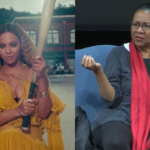“Marrying up” is easier than ever. Well, maybe.
By Lics Ludy
Daily Koz, December 15, 2015 —

How lovely can white be?
To begin, it’s necessary to say that in my view, biracial marriages can be healthy and based on values that are not problematic. But it is unfair to dark-skinned women to deny that light skin still holds lots of clout, putting them at a disadvantage. To imply that biracial marriages are a sign of cultural advancement is no more honest. Colorism is a real thing. And there are consequences, plus those benefits to a chosen few.
It is also necessary to set aside the argument that race is not biological. In practice, personal attributes like beauty, attitude and personality are still separated and categorized according to race: Straight hair, even if it’s fake or purchased in the industry that” cheats it” from a poor South Asian woman is prettier, Asian women and Latinas women are supposedly easier and more passive, Black women “take no sh*t, and so on, Native women need a nose job. Asian women need blepharoplasty to create eyelid creases and so on.
Some of us are still convinced that we are in a better place in society because the numbers indicate that more and more people find interracial marriage at least acceptable for someone else. The resulting children are still very often considered more beautiful than any “one race” person. The challenge is in the “whys” and in identifying the resulting problems.
I once had a conversation with a White woman who described an encounter with a Black man who wanted to date her. This man told her he only dated White women and had a list of reasons why. He also told her that he married a White woman before because he wanted to have light children. This guy did not get his date, but I am aware that some of these men do successfully find and marry White women who believe, or at least go along with their analysis.
In this society where physical factors like extreme thinness and light skin still dominate media and even women of color-focused magazines, we must examine the mental health concerns that evolve for women from this level of some men of color’s internalized oppression. Here are some of the factors, based in observations during my many years of work in multiple cultural contexts, settings, states, countries and personal experiences.
Professional factors
A very successful Asian professional spoke in one of the university classes I taught. In telling his story of evolving and reclaiming his Asian identity, he identified that he had to admit that having the perfect blonde wife was one of the key factors he learned and accepted in what it was going to take to climb the professional ladder. He did accomplish both (the white wife and a big climb up the professional ladder.) A personal and professional crisis pointed out to him that no matter how perfect he was at the job, there were always White men of less capacity who continually gained what he could not. Once he recognized the racism, he also had to recognize that minimizing his Asian-ness was what had been doing, which then caused him, among other things, to consider what messages he had been teaching his children about being half Asian. He also began a very deep search into what needed to be different and how to be a part of the solution to racism. One of the things he did was change his name back to the traditional name, given to him as a baby. He took part in groups that strive to accomplish some of those changes. What I don’t know is how far he went in influencing his children to be more connected to their Asian roots. What I do know is that his professional success, albeit not what he’d like, is far beyond the average person of color. His situation demonstrates that presenting a certain way seems to have its reward, to a point.
Personal Factors
A few White women I have had exposure to, from college days to quite recently, have experienced Black men who dislike other Blacks so much that they tell their White spouse lies about Black culture and why they need to continue (or can’t avoid) certain behaviors that are not acceptable to her. He might be taking advantage of her ignorance of the full range of Black cultures because she grew up in an all-white environment. He might be yelling certain kinds of obscenities when upset or what he won’t eat. Another outcome might be why he says he cannot find a diverse school for their children, supposedly because schools that have “too many Black kids” are always of lower standard. He might be exploiting her White guilt. Another thing I have encountered quite often is the factor of internalized oppression in which some families of color, say some Latinos and African Americans, who coo over a new baby, overtly stating that the child’s light skin, hair or eyes makes them so gorgeous. Forget that a darker child or adult is in the room when they say it.
Once I was in conversation with a very dark-skinned Sub-Saharan African woman who had recently married a White American man and openly admitted that she “couldn’t wait to have light-skinned children.”
A biracial (Asian and White) male tells the story of his Asian parent making fun of his sibling who looks the most Asian.
The light-skinned parent of a Black Caribbean teen blames his truancy and involvement in petty crime on the fact that he is hanging out with the U.S.-born Black kids. That is not an issue I’ve found that the average White human services professional understands with any sophistication. I was nowhere near the first professional the family had encountered. My take was that most of the Black kids that he had access to were in trouble. His notion of “becoming American” was tainted. His access to properly focused intervention was nil.
In a Native family and in a Latino family, the fathers instruct the daughters that bringing home a White boyfriend is acceptable. However, bringing a Black boy home is grounds for trouble. “Marrying up” is a not-so-subtle directive, at times.
Emotional Damage, Large and Small
When I was in high school, there was an African American boy who I liked. He actually would rarely even make eye contact with me. It took me awhile to realize that the girls he would talk to were ALWAYS White. Always. It was the beginning of many realizations about being “coffee and cream” in skin tone, as opposed to milk-pale. It’s the Black girl lesson. Luckily, given my interests and exposures, I’ve managed to get around this impediment, having dated every skin color under the sun. However, the idea that a person has the right to pick what they are attracted to evades the issue of what internalized oppression does to self concept of the dark person, who too often compromises in relationships. “Having something rather than nothing” is too often the slippery slope to taking emotional abuse and worse. It also evades that a version of White privilege operates quite openly in some biracial families. (i.e. the White parent may refuse to be in the minority in social situations, where the POC parent may be, or even prefer being in that position quite often. Maybe the White husband who bought a certain foreign mail order bride expects her passivity and because she has no personal U.S. context before she comes, she accepts his prejudices. In that case the non-White child coming out of that family may hold the socio-political views that possibly cause them to enable or enact a long list of -isms that actually work against other people of color.)
A biracial (Black and White) teen, who was beginning to abuse a drug and had developed an eating disorder felt that she was ugly. She explained that she was “the only girl in school that isn’t skinny.” My observation was that she was quite pretty. but with dried-out, over-processed hair. Yes, and with the “typical” curvy, Black woman physique. Not skinny. But certainly not fat. I learned that there were only a couple of Black girls in her own school. Her mother who she lived with, is White. Her father, by her description, wanted her to stay in the schools that were primarily White. Her mother, by her report, seemed to have no position on the matter.
An adult male learns as an adult that one of his parents is half Black, a fact that was never mentioned once by anyone in the family. He was searching for Black people to get to know. He didn’t in any way look Black, so his awkward fumbles in learning about himself were quite odd to some people. Another adult male learns that one of his parents is half Native. An adult woman learns that both her parents were half Native, but never told her and her siblings. When she began trying to learn about the tribal affiliations, her parents disowned her.
Young college students who were raised in predominantly White communities by their biological parents of color are sometimes only comfortable with White peers. What kind of partner will they choose and what values and biases will they teach their children?
The Solutions
Not every adult raised in the circumstances I describe has mountainous problems. But scraping the surface of substance issues, depression, self esteem concerns that seem to have no understandable basis pretty often produces colorism as a core factor. If the therapeutic professional has no knowledge on how this may be a central issue in a patient’s problem, how good is their intervention going to be? How often would it occur that a patient who grew up with this kind of family value has one of these factors to throw into the therapeutic session, but not realize it is connected? If the universities that train teachers, therapeutic professionals and spiritual leaders don’t include in-depth training on this topic, we are doing a lot of people a disservice.
In my professional career, I have found the issues too provocative and politically unsafe to make it worth it to a school, university or other program to press the issue of true cultural proficiency but so far. What unnecessary wounds might students, employees or prospective patients carry because there is not enough courage to address this issue fully? My solution is simple: we HAVE TO do better with this, as transracial adoption and interracial marriages continue and middle and upper class people of color move to the suburbs and small towns that make them “the minority of the minority.” We have to, as a society, understand internalized oppression and its symptoms. We have to stop elevating the value of overly-assimilated or light-skinned people of color, or what is known in the fashion and advertising industries as the “racially ambiguous.”
There is a huge range of healthy self-concept and beauty and we have to help it thrive.
Pew Research Center: Interracial marriage: Who is ‘marrying out’?
The Huffington Post: The Changing Business of Black Hair, a Potentially $500b Industry
The Guardian: The hair trade’s dirty secret
www.dailykos.com/story/2015/12/15/1459788/-The-Search-for-Light-Skinned-Children










